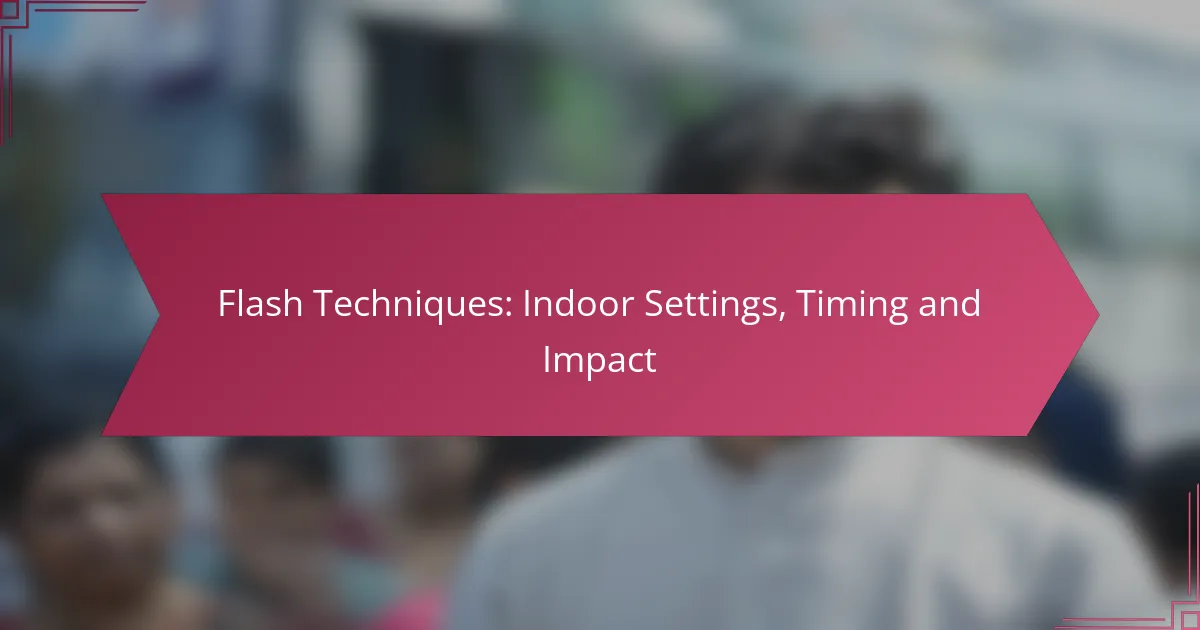Mastering flash techniques in indoor settings is essential for achieving optimal lighting and enhancing image quality. By utilizing methods such as off-camera flash, bounce flash, and fill flash, photographers can create dynamic and visually appealing images. For those looking to elevate their skills further, exploring cinematic wedding photography lighting techniques can provide valuable insights. Timing and synchronization with the camera’s shutter play a critical role in maximizing the impact of flash, allowing for better motion capture and exposure control.
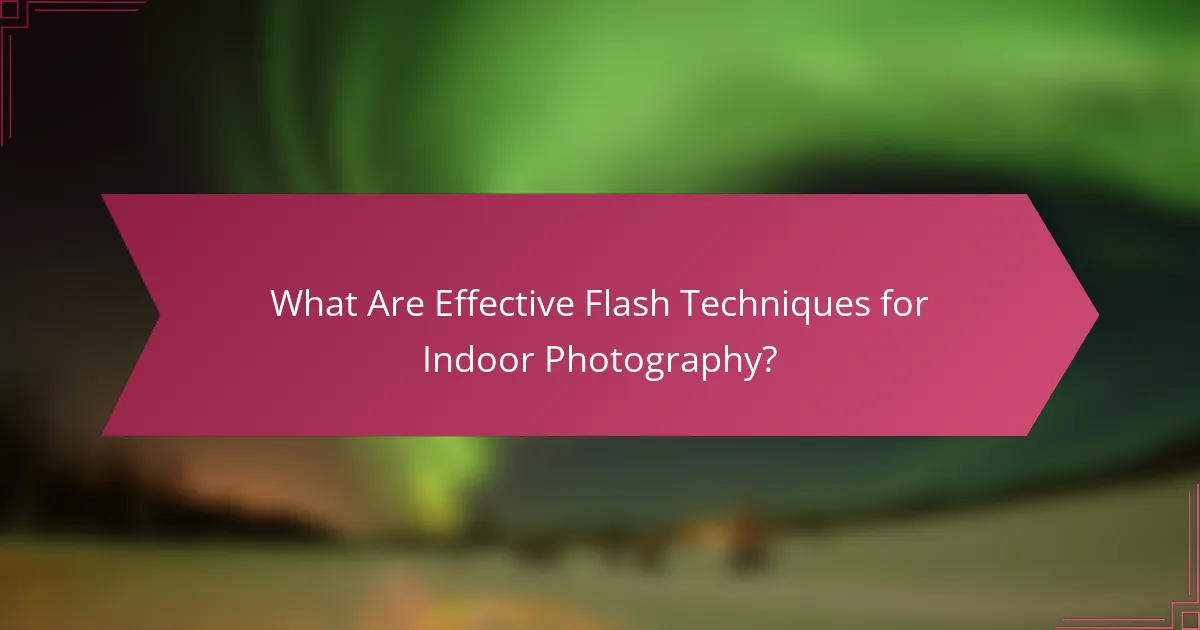
What Are Effective Flash Techniques for Indoor Photography?
Effective flash techniques for indoor photography enhance lighting and improve image quality. Key methods include using off-camera flash, bounce flash, fill flash, high-speed sync, and flash modifiers to achieve the desired exposure and mood.
Using Off-Camera Flash
Off-camera flash allows you to position the light source away from the camera, creating more dynamic and interesting lighting. This technique can help reduce harsh shadows and provide a more natural look.
To use off-camera flash effectively, consider using a wireless trigger or a sync cable. Experiment with different angles and distances to find the best lighting for your subject.
Utilizing Bounce Flash
Bounce flash involves directing the flash towards a reflective surface, such as a wall or ceiling, to soften and diffuse the light. This technique helps to create a more flattering and even illumination on your subject.
When using bounce flash, aim for surfaces that are white or light-colored to maximize reflection. Be mindful of the distance, as bouncing light can reduce its intensity, so you may need to increase the flash power accordingly.
Employing Fill Flash
Fill flash is used to illuminate shadows in bright conditions, ensuring that your subject is well-lit without losing detail. This technique is particularly useful in high-contrast situations, such as outdoor portraits taken in direct sunlight.
To implement fill flash, set your flash to a lower power setting, typically around one to two stops below the ambient light. This subtle approach helps to balance the exposure between the subject and the background.
Integrating High-Speed Sync
High-speed sync (HSS) allows you to use flash at shutter speeds faster than the camera’s sync speed, which is crucial for freezing motion or shooting in bright environments. This technique is beneficial for capturing sharp images of moving subjects indoors.
When using HSS, be aware that it may reduce the effective range of your flash. Adjust your settings accordingly to maintain proper exposure, and consider using a wider aperture to compensate for the loss of light.
Using Flash Modifiers
Flash modifiers, such as softboxes, umbrellas, or diffusers, help to soften and spread the light, resulting in a more pleasing effect. These tools can significantly improve the quality of light in your indoor photography.
When selecting a modifier, consider the size and type based on your shooting environment. Larger modifiers create softer light, while smaller ones can produce more focused beams. Experiment with different modifiers to see which best suits your style and subject matter.
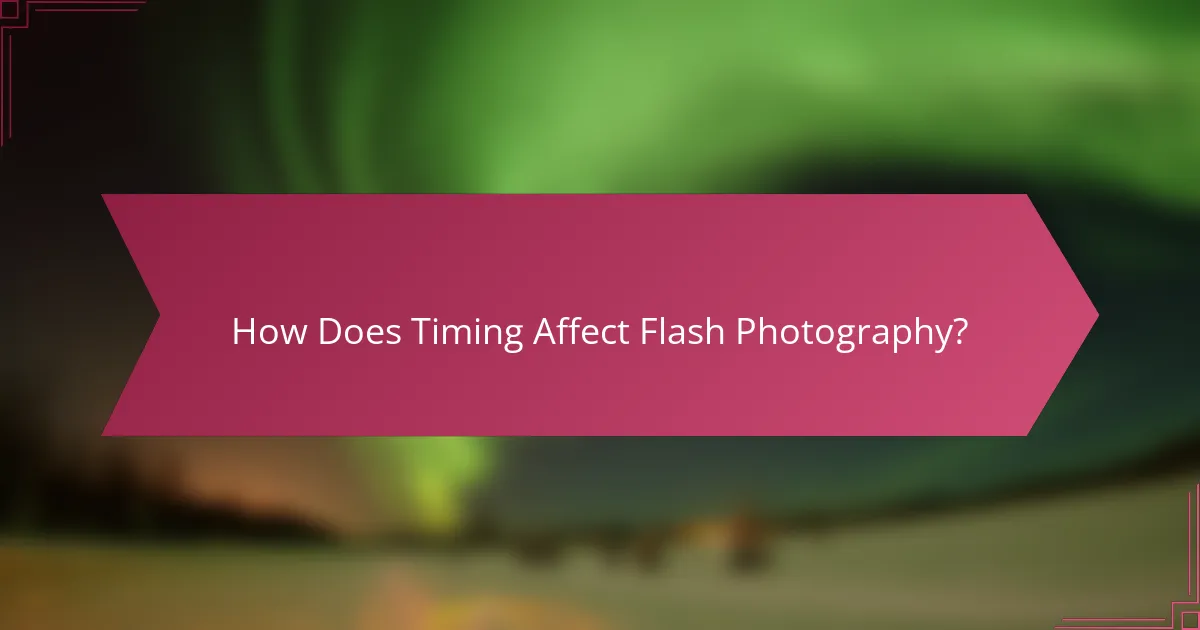
How Does Timing Affect Flash Photography?
Timing is crucial in flash photography as it determines how the flash interacts with the camera’s shutter. Proper synchronization can enhance image quality, freeze motion, and create desired effects in various lighting conditions.
Understanding Sync Speed
Sync speed refers to the maximum shutter speed at which a camera can effectively use flash without causing parts of the image to be underexposed. Most cameras have a sync speed ranging from 1/200 to 1/250 seconds. Exceeding this speed may result in a partially lit frame, as the shutter may not fully open when the flash fires.
To find your camera’s sync speed, consult the user manual or check the specifications online. Using a slower shutter speed can allow more ambient light, which can be beneficial for balancing flash with natural light.
Utilizing Rear-Curtain Sync
Rear-curtain sync is a technique where the flash fires just before the shutter closes, creating a natural motion blur effect. This is particularly useful for capturing moving subjects, as it gives the impression of movement in the direction they are traveling.
To use rear-curtain sync, enable the setting in your camera’s flash menu. This technique is ideal for low-light situations, such as night photography, where you want to emphasize motion while still highlighting the subject with flash.
Timing for Action Shots
When photographing fast-moving subjects, precise timing is essential to capture the action effectively. A high sync speed combined with a quick burst mode can help freeze motion, ensuring sharp images of sports or wildlife.
Consider using continuous shooting mode to take multiple shots in rapid succession. This increases your chances of capturing the perfect moment. Additionally, practice anticipating the action to trigger the shutter at the right moment, enhancing your overall success rate.
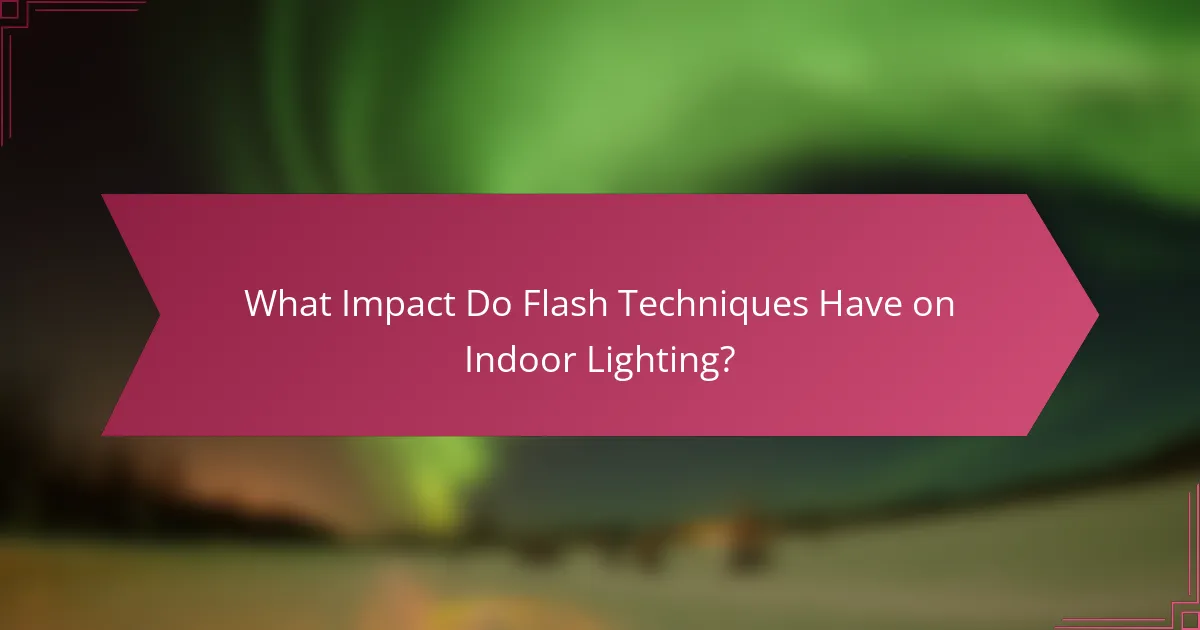
What Impact Do Flash Techniques Have on Indoor Lighting?
Flash techniques significantly enhance indoor lighting by providing controlled illumination that highlights subjects and creates desired effects. These techniques can transform the quality of light, making images more vibrant and visually appealing.
Enhancing Subject Visibility
Using flash techniques indoors can dramatically improve the visibility of your subjects, especially in low-light conditions. By directing light towards the subject, you can eliminate shadows and ensure that details are clearly visible.
When employing flash, consider the distance between the flash and the subject. A flash positioned too far may result in underexposed images, while one too close can cause harsh lighting. A good rule of thumb is to start with the flash at a distance of about 1.5 to 3 meters and adjust as necessary.
Creating Mood and Atmosphere
Flash techniques can also be used to create specific moods and atmospheres in indoor photography. By adjusting the intensity and direction of the flash, you can evoke feelings ranging from warmth and intimacy to starkness and drama.
For instance, using a soft flash with a diffuser can create a gentle, inviting atmosphere, while a direct flash can produce a more dynamic and energetic feel. Experimenting with different flash settings and modifiers can help you achieve the desired emotional impact in your images.
Controlling Shadows and Highlights
Effective use of flash allows for better control over shadows and highlights in indoor settings. By positioning the flash at various angles, you can manipulate how light interacts with your subject, enhancing textures and depth.
To minimize unflattering shadows, try bouncing the flash off walls or ceilings. This technique softens the light and spreads it more evenly across the scene. Conversely, if you want to emphasize certain features, direct flash can create sharp highlights that draw attention to specific areas.
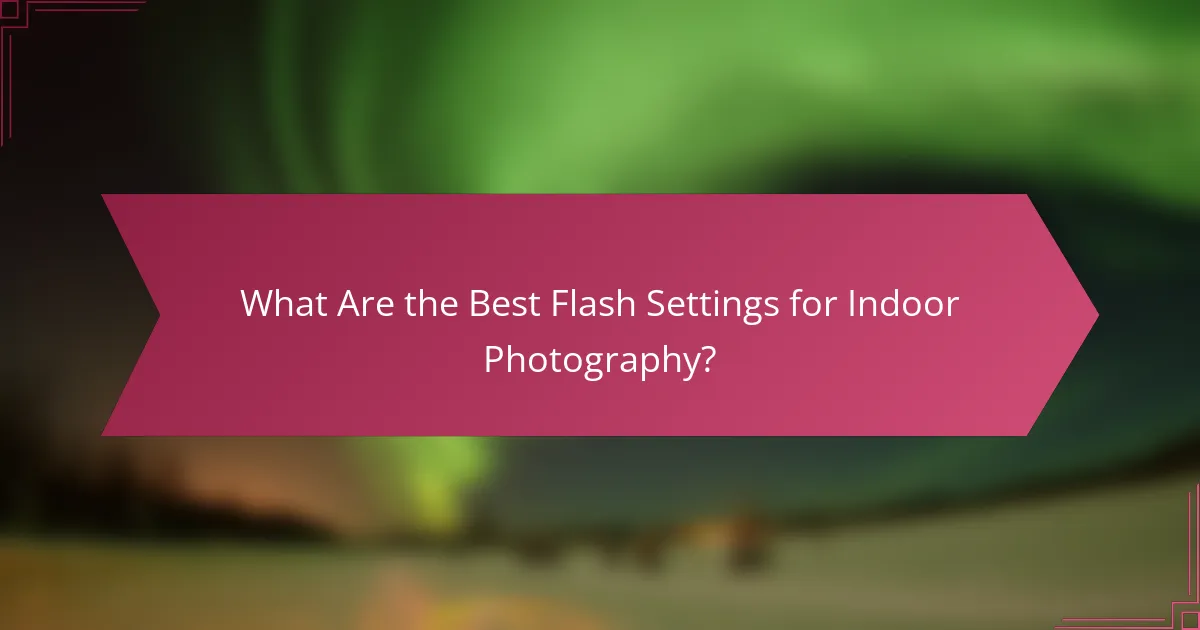
What Are the Best Flash Settings for Indoor Photography?
The best flash settings for indoor photography depend on achieving a balance between ISO, aperture, and shutter speed to capture well-exposed images. Understanding how these elements interact will help you create stunning indoor shots with the right amount of light and detail.
Optimal ISO Settings
For indoor photography, a good starting point for ISO settings is typically between 400 and 1600. Higher ISO values can help in low-light situations but may introduce noise, so it’s essential to find a balance that works for your camera.
Consider using lower ISO settings, like 400, in well-lit indoor environments, while higher settings may be necessary in darker spaces. Always check your camera’s performance at various ISO levels to determine the best setting for your specific situation.
Aperture Recommendations
Aperture plays a crucial role in controlling the amount of light entering the camera. For indoor photography, an aperture of f/2.8 to f/5.6 is often ideal, allowing sufficient light while maintaining a good depth of field.
Wider apertures (like f/2.8) are beneficial for isolating subjects and creating a blurred background, while narrower apertures (like f/5.6) can keep more of the scene in focus. Adjust your aperture based on your subject and the desired effect.
Shutter Speed Guidelines
Shutter speed is vital for freezing motion and avoiding blur in indoor photography. A general rule is to use a shutter speed of at least 1/60 seconds when shooting with flash indoors, but faster speeds may be necessary for moving subjects.
When using flash, you can often use slower shutter speeds, as the flash duration is brief enough to freeze motion. However, be cautious of ambient light exposure; if the shutter speed is too slow, it may lead to overexposure from surrounding light sources.
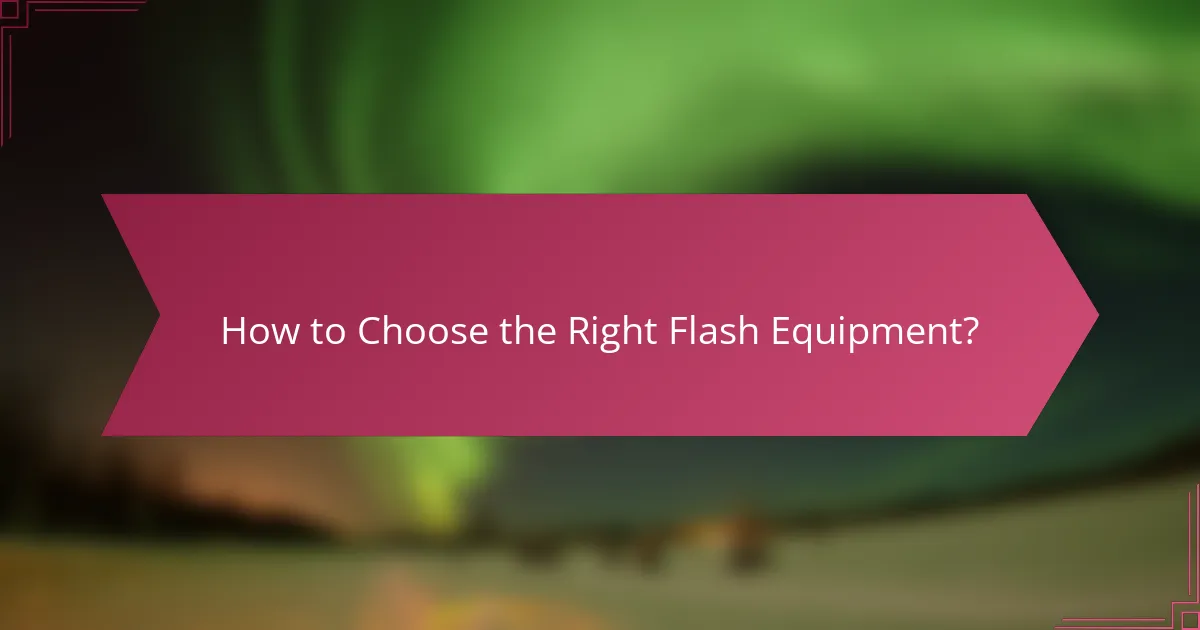
How to Choose the Right Flash Equipment?
Selecting the right flash equipment involves considering your specific photography needs, the environment, and your budget. Key factors include the type of flash, its power output, portability, and compatibility with your camera system.
Comparing Speedlights and Studio Flashes
Speedlights are compact and portable, making them ideal for on-the-go photography. They typically offer lower power output compared to studio flashes but are versatile for various indoor settings.
Studio flashes, on the other hand, provide higher power and consistent lighting, suitable for controlled environments. They often require a power outlet and can be bulkier, limiting their portability.
- Speedlights: Lightweight, battery-operated, great for events.
- Studio Flashes: Higher output, ideal for portraits and product photography.
Evaluating Flash Brands: Canon vs. Nikon
When comparing Canon and Nikon flash systems, consider compatibility with your camera and the range of features offered. Both brands provide reliable options, but their flashes may have different functionalities and user interfaces.
Canon flashes tend to integrate seamlessly with Canon cameras, offering features like E-TTL for automatic exposure. Nikon flashes, with i-TTL, provide similar automation but may excel in specific scenarios like high-speed sync.
Ultimately, the choice may come down to personal preference and existing equipment. Test both brands if possible to see which aligns better with your shooting style.
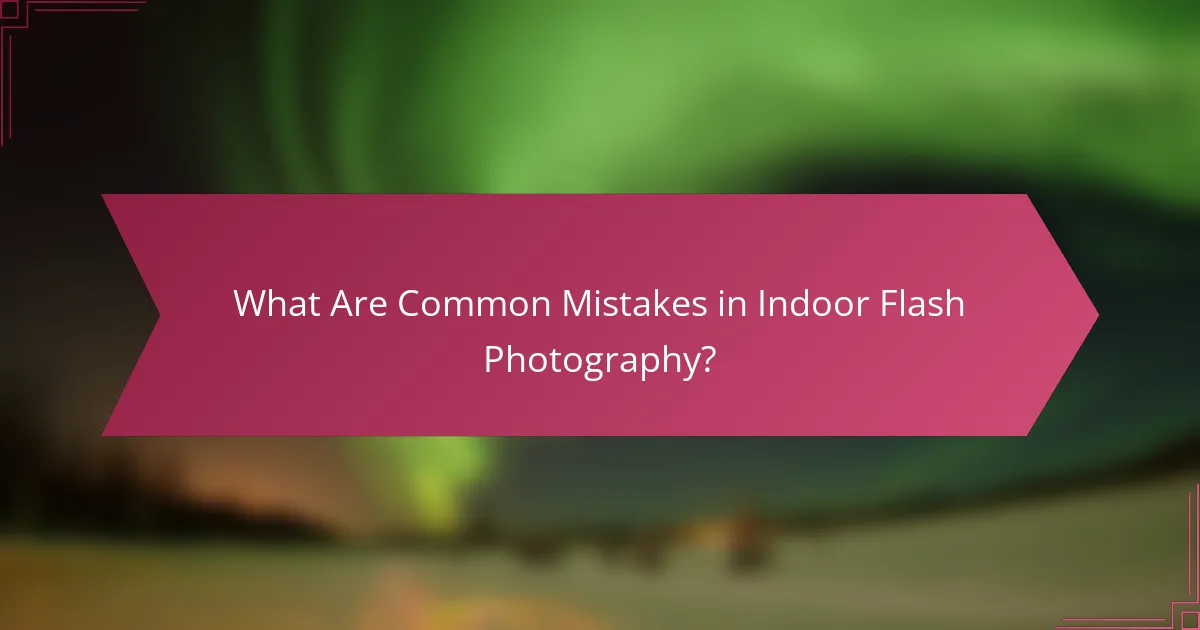
What Are Common Mistakes in Indoor Flash Photography?
Common mistakes in indoor flash photography include overexposing subjects and neglecting ambient light. These errors can lead to unflattering images that fail to capture the intended mood and detail.
Overexposing Subjects
Overexposing subjects occurs when the flash is too strong, resulting in washed-out highlights and loss of detail. This often happens when the flash power is set too high or the subject is too close to the flash source.
To avoid overexposure, use a lower flash power setting or increase the distance between the flash and the subject. A good rule of thumb is to start with a flash power that is one to two stops lower than the camera’s metered exposure.
Neglecting Ambient Light
Neglecting ambient light can lead to unnatural-looking images where the flash dominates the scene. Balancing flash with existing light creates a more natural atmosphere and depth in your photos.
To incorporate ambient light effectively, consider using a slower shutter speed while keeping the flash synced. This allows more of the room’s light to enter the camera, enhancing the overall exposure. Aim for shutter speeds around 1/60 to 1/125 seconds, depending on the available light.
